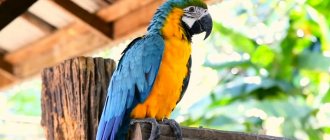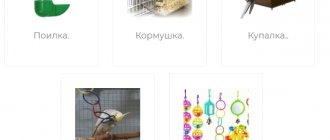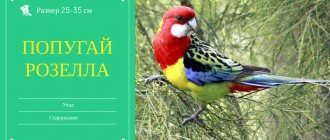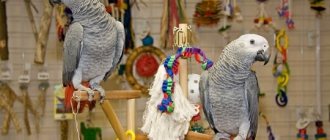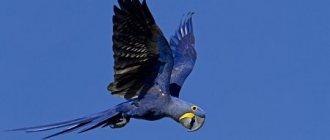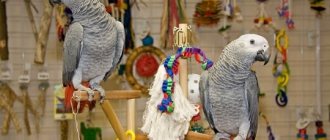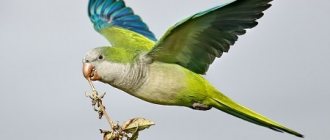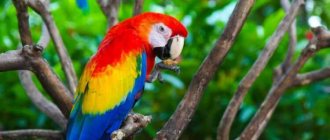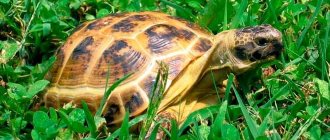- home
- Parrot
- Kinds
09.26.2019 The African Gray parrot is a difficult bird with character that can be a friend for life if the relationship is built correctly. To do this, you need to know the character traits and care of the gray bird, which brings trouble, joy and good mood to the house.
Description of Gray
The main characters of the films have parrot friends with bright colors, sharp intelligence and large sizes. The gray parrot is also smart, but does not have exotic colors. His plumage is modest, of two colors: gray (of varying saturation) and red.
The feathers on the head are small, like scales, and there are large areas of bare skin around the eyes. Therefore, the second name of this breed is “gray parrot”. Gray sizes vary from 30 cm to 40 cm. Weight from 300 to 500 g.
The beak is large, black, curved down. Adult parrots have yellow eyes, gray paws, and a black beak.
What to be prepared for
Noise
Jaco is a very talkative bird. All the time he is awake, the gray parrot will say something and make sounds. The range and volume of his vocal capabilities are colossal.
You need to be prepared for noise from a parrot
He will communicate with you, with household members, with other animals, with TV, with radio, and with himself. There is no way to stop this fountain.
Therefore, correlate your desire to have these birds with your emotional capabilities and levels of patience.
Read also
Growth on the beak of a budgerigar
Garbage
Gray parrots are energetic birds. They love to chew and throw everything around. They have no idea about the accuracy of eating.
The entire space around the cage will be constantly strewn with all kinds of debris. And it will have to be cleaned constantly. Keep this in mind too.
Expenses
Everything is expensive. From the cost of the cage to a complete diet. The birds themselves are also not cheap. This is about money. And there are also time costs that no one can reimburse you.
Keeping a African Gray parrot is quite expensive.
Parrot species
Grays belong to the subfamily of parrots Psittacinae in the genus Psittacus. There are differences in appearance between different species:
- Brown-tailed Gray, which has dark gray plumage and an ivory beak. The body length is around 30 cm. Breeders have recorded cases of the birth of chicks interspersed with feathers of yellow or pink shades.
- The Red-tailed Gray has plumage that is a lighter shade of gray. The tail has bright red feathers. 7-10 cm longer than the brown-tailed one.
- Royal Gray (Ghanaian Princess Gray). Along the dark gray plumage are red feathers. This is the largest of all Grays and the most interesting in color.
When breeding in captivity, a pair of one species may produce offspring of another species. Breeders do not give an exact explanation for this phenomenon.
Price
In our country there are very few breeders of large parrots, as a result of which the cost of a chick is high, approximately 150 thousand rubles. A talking gray will cost the buyer about 300 thousand rubles.
To raise a pet, it is recommended to purchase a male parrot at the age of 2-3 months from a trusted nursery. The bird for sale must have a ring on which information about the origin is placed, with accompanying documents. Tame parrots are less susceptible to stress and adapt better to a new environment.
The price of a gray coat depends on factors:
- age;
- color;
- place of birth;
- speaking skills.
Chicks up to a year old can be identified by the gray iris of the eyes, the smooth scaly covering of the legs, and burgundy-colored feathers with gray ends in the tail. It is impossible to visually estimate the age of birds older than one and a half years. The Gray in the photo for sale may differ significantly from the real bird when purchased. Random online sellers should be avoided.
Habitat and lifestyle
The gray parrot lives in the wild in central and western Africa. It can be found in the tropical forests of Liberia, Congo, Guinea, and Sierra Leone.
They live in flocks or pairs. Hollows in trees are suitable for nesting; the higher, the better. Sometimes several pairs can nest on one tree.
Birds spend almost the entire daylight hours in search of food. Favorite food is the fruits of the red oil palm. Can cause damage to banana plantations and agricultural land. To find food for itself, a parrot from the tropics of Africa is able to travel considerable distances.
In the evening they return to their trees and sleep on the high crowns. This is how birds try to protect themselves from poachers and predators.
Keeping Jaco at home
The Gray bird is an ideal indoor bird: phlegmatic and almost silent. It is most active in the morning and evening. From the outside it looks like “physical exercise”. The feathered pet makes abrupt exclamations and whistles of different tones, mutters or clicks its beak.
At home, Jaco very quickly becomes attached to his owner. Curiosity and observation have no limits. Among the family members, he will definitely have a favorite, from whom he will not leave a single step and try to please him in every way. Likes to repeat everything the owner does. You can sit on the couch with him and watch TV. Feathered animals are no strangers to such feelings as jealousy and envy. It responds to aggression with aggression, and its bites can be quite sensitive. It has been noticed that females are calmer and more silent than males and try to avoid conflicts.
Before getting such a pet, you need to carefully read the recommendations of experienced breeders and read reviews from owners on how to properly build relationships with Grays.
How to choose the right one
When choosing a parrot, it is important to make sure that there are no fatty deposits on the body in the sternum area (checked by careful palpation)
It is best to purchase Gray parrots in pet stores or special nurseries, where the buyer will be able to provide all the necessary documents for them.
It is strictly not recommended to use the services of private sellers: for a very tempting price, you can become the owner of an old wild and sick bird, which will be impossible to tame.
Gray chicks raised in nurseries are especially kind, affectionate and friendly. They become true friends and favorites of all family members. Young individuals adapt to new conditions as easily and quickly as possible and begin to talk before the age of five months.
Important nuances that you should definitely pay attention to before purchasing will help you choose a healthy young parrot:
- active and cheerful behavior of the bird;
- integrity and natural purity of feathers;
- absence of residues of droppings and dirt in the area around the cloaca;
- no deposits in the nostrils;
- clear eyes of a dark gray hue (in birds older than a year, the iris begins to gradually lighten), “lively” look;
- smooth scales on the paws;
- smooth beak.
Arrangement of the cage
The bird is large and needs a spacious cage-aviary. The red-tailed parrot is active, loves to frolic, space should not hamper its movements. Minimum cage dimensions 65x4x80 cm
The rods must be strong and metal. The lock on the door needs to be complex, because Gray loves to solve puzzles that are aimed at his freedom of movement.
The cage for a Gray Gray should be positioned so that the bird is at the level of the owner sitting opposite. If it is higher, the bird’s character may deteriorate, as it will quickly feel its dominance. An automatic drinker and at least two feeders are placed in the cage. Accessories include a ladder, perches, a mirror, and wheeled toys.
It must be taken into account that the pet will spend most of its time “in the wild”, next to its owner. Therefore, before buying a bird, you need to prepare not only the cage, but the entire house, removing all dangerous objects. The pet must be given the opportunity to contact its owner as often as possible.
An active pet needs at least 10 hours to sleep and rest. Therefore, at night he will sleep and will not interfere with the sleep of the household members.
Diet
These birds are not picky when it comes to food. The fruits of the oil palm, which he loves in captivity, are, of course, impossible to provide him with. But they can be successfully replaced by ordinary sunflower seeds. They must be of high quality and not fried. But this is not all that a pet needs for full development.
Meals should be varied:
- twigs of bushes and fruit trees;
- any nuts except almonds;
- grain mixture (wheat, oats, corn);
- green peas, dill, spinach;
- mineral and vitamin supplements;
- vegetables and fruits.
If your pet is reluctant to eat wheat and oats, then they need to be sprouted.
You cannot feed the Gray from the owner's table, as this will lead to gastrointestinal disorders. Hot, salty and spicy foods should be kept away from the bird.
How to convince Grays to eat a varied diet?
Gray parrots are very conservative by nature. If at an early age they are not taught to try different foods, then in adulthood it will be difficult to persuade them to eat healthy and nutritious carrots. But don’t despair, here are some effective tips:
- The best example for a feathered pet can be the owners themselves. Eat broccoli and other goodies in front of your gray friend. The bird's curiosity should take over. Not today, but in a month.
- Present food as a toy. Place the lettuce leaves not in a regular feeder, but hang them using special devices, skewers, or clothespins.
- Offer food in a variety of formats. Some birds prefer grated vegetables, while others only eat diced ones. Use your imagination to identify your pet's taste preferences.
- Praise the bird even if it just touched a new product.
- Hide food, for example by wrapping cereal in paper like candy. Let the parrot fuss and try to turn around to get to the tasty treat.
Care and hygiene
You need to care for your gray parrot in the same way as any other feathered pet: clean the cage more often, wash accessories, feeders, and toys. Clean water must be poured every day. Jaco loves to splash in the water. A warm shower gives him real pleasure. Twice a week the parrot is given a bath day. You can use a shower or provide your pet with a bath cup.
The owner of the bird needs to be prepared for the fact that he will have to clean not only the cage, but also the area around it. Not all parrots use their cage for the toilet. But it’s not always possible to get used to this.
Expenses
Keeping this gray parrot can be very expensive for many. The largest financial investment is, of course, the cage. But don’t forget about the ongoing costs associated with keeping a pet. In order for a parrot to be healthy and well-groomed, it requires a balanced diet, an abundance of minerals and vitamins. The Gray's diet cannot be limited only to dry grain mixtures; the bird's menu must include large quantities of various fruits, vegetables, herbs and cereals.
Apart from special reusable toys that can withstand the Gray's beak, then toys made of wood, wicker, and rope will become permanent consumables. Such toys quickly turn into splinters, and yet it is better to offer them to the parrot if you do not want your sofa or other piece of furniture to become the object of gnawing. In addition, toys are necessary so that the parrot can entertain itself independently. Boredom is one of the worst things for Grays. A busy parrot (with toys or playing together with the owner) is the key to the emotional and physical health of the pet.
The online pet store “Kakadushka” offers some of the best conditions in Russia in terms of the price of goods plus delivery. Below are some links to the main product groups:
- Prices for cages for parrots – all kinds of “dwellings” for feathered pets are presented here; use the filter to select suitable models.
- And in this section you can estimate the cost of toys for birds. Some accessories made from durable acrylic or metal will last a long time, while others will be broken by your pet. And you need to understand that destruction is a normal part of your pet’s life.
- Buying food for a parrot in the form of a dry grain mixture is necessary, but not enough. Proper nutrition should also include greens (for example, sprouted grains, dandelion, lettuce or young nettles), fruits, berries, vegetables, cereals, and branch food.
Is it possible to teach speaking?
Gray parrots that do not speak are rare. Birds can remember more than a thousand words and about three hundred sentences. It has been noticed more than once that they use words in an associative, meaningful way and with exactly the intonation that is appropriate for the situation.
When settling in the house, the pet will take a closer look at those around it for some time. First, he needs to get used to the situation, to the household members, and to gain confidence in them. The learning process begins with one or two phrases. The most easily reproduced letters are k, s, t, r, ch, sh. Words containing other letters do not sound as quickly and with difficulty.
When the pet itself shows interest in learning and sees obvious benefits for itself, the process will proceed at a rapid pace. At the same time, the bird can be trained to perform various tricks. If you choose between a cockatoo or a gray one, the second one has more speech production abilities. You need to practice every day and be patient.
Jaco can not only easily repeat human speech, but also the sounds that he hears around him: for example, the ringing of an alarm clock, the crowing of a rooster, and even the buzzing of a razor that the owner uses in the morning.
Advantages and disadvantages
The main advantages of the Gray parrot are:
- extraordinary intelligence and intelligence, allowing you to play with the bird, solve puzzles and riddles;
- a cheerful disposition and perky mood that can instantly dispel boredom;
- the ability to perform funny acrobatic stunts;
- excellent ability to learn, with the right approach to which the bird not only learns to reproduce speech and various sounds, but also does it according to the theme, causing incredible delight among listeners;
- showing a sense of affection and love for the owners;
- the noble beauty of the plumage, which calms and adds zest to the interior of the room where the bird is located.
There are also disadvantages:
- an abundance of debris (feathers, fluff, food particles, droppings);
- damage to various objects with a powerful beak;
- the likelihood of involuntary injury to a person;
- a rather complex character and an aggressive response to the owner’s dissatisfaction and aggression;
- considerable financial costs (cage, toys, food, visits to the veterinarian).
Diseases and their prevention
Looking at a photo of a gray parrot, it is difficult to imagine that these large, strong-looking birds can get sick.
Factors that can lead to illness:
- developed pathogens in a dirty cage;
- stagnant water in a long-unwashed drinking bowl;
- old low-quality food;
- unbalanced diet;
- stress and depression from inattention to birds;
- physical injuries.
Non-contagious diseases in parrots include obesity and poisoning. Among the most likely infectious diseases are aspergillosis, tuberculosis, and paratyphoid fever. Parasites can accompany birds from Africa itself. These diseases can be recognized at an early stage if you carefully monitor your pet.
Proper and modern treatment is a condition for the bird’s recovery. Unfortunately, it is impossible to cure a bird from tuberculosis.
Reproduction and lifespan
The breeding season for Grays in their natural environment occurs during the rainy season. Birds create pairs for a long time, showing constant affection for their partner. The mating ritual consists of dancing around the chosen female and treating her to brought fruits and nuts. The voices emitted by the couple are similar to whining and grunting. The female Gray in mating behavior behaves like a chick while receiving food.
The mating stage is accompanied by the construction of a nest. Birds choose a place for their “home” in old tree hollows, away from prying eyes. The clutch usually consists of 3-4 eggs.
Incubation occurs within a month. Newborn Gray Gray chicks require a lot of attention at first; the female is constantly in the nest. The male takes care of food and protecting the family.
Parental care continues for up to two to three months while the offspring’s wings grow. The fledged chicks fly out of the nest, but do not show complete independence and still need the support of their parents for some time.
Breeding Grays in captivity is quite a problematic task. The artificial creation of pairs does not give the expected result - the birds live together, but without offspring. Having sympathy is an indispensable condition. Great luck if the process of courtship and nesting begins.
The life expectancy of a gray pet depends on the quality of maintenance and care. Many pet parrots die prematurely from food poisoning and injuries. It is not recommended to leave Grays outside the cage unattended.
Inexperienced owners bring birds to a state of self-plucking, which reflects a serious malfunction of the body. Behavioral disorders are also a consequence of the owner’s mistakes in keeping the pet.
Nature has endowed a healthy bird with a long life span, approximately 45-50 years. Communication between a parrot and a person can reveal all the talents of a Gray, but can lead to a tragic outcome. The physical and psychological health of the pet depends on the owner of the bird.
Causes of death
A bird can die from advanced, untreated diseases or injuries incompatible with life. It is impossible to leave the Gray alone flying freely around the house. He could get stuck somewhere and suffocate, get hurt on a sharp object, or get burned by an open flame. He is in danger of being electrocuted if, out of curiosity, he pecks at an electrical wire.
Left without attention and supervision, the bird becomes sad, its character deteriorates, its nervous system suffers, and its appetite disappears. All this can worsen to such a state that the pet dies.
For a Gray, a meeting with a cat or dog can end sadly. A parrot can fly out of a window or an open window and not return.
Poisonous indoor plants, such as azalea, aloe, amaralis, dieffenabachia, oleander, hydrangea and monstera, can lead to the death of a bird.
Sprouted food
Sprouts are a tasty product that only a rare bird would refuse. They have a high content of vitamins, minerals and antioxidants precisely during the germination process. You can germinate grains either from ready-made mixtures, having previously selected mineral additives and components that are not involved in germination, or from special mono-mixtures.
List of grains and seeds for delicious sprouts: oats, wheat, mung beans, chickpeas, green peas, lentils, quinoa, sesame, millet.
How to cook sprouts?
- Rinse the grains with water and soak them overnight in special containers for germination or in a regular plate with gauze, you can also use a sieve.
- The next day, rinse them and put them in the refrigerator without filling them with water.
- White roots will appear on the second day.
- Offer sprouts up to 5-6 mm long; if they grow longer, it’s okay, but they will taste unpleasantly bitter to the bite.
Regular grass made from oats and wheat are also useful for the gray robber; add nettle, dandelion, lettuce, fireweed, plantain, and carrot tops to the diet.
Intelligence level
The cost of a gray parrot is considerable, since this bird is one of the smartest birds on the planet. Scientists compare the intelligence level of a Gray Gray and a five-year-old child. In brown-tailed birds, the ability to remember words appears earlier than in red-tailed birds.
Domestic Grays are smart and emotional, each parrot has its own character and excellent memory. He needs communication and movement. You can't buy it off with toys alone. You have to play with him. Jaco will be happy to participate in all games and activities of the owner. He will be interested in a computer, TV, washing machine and hair dryer. You will have to allow the bird to explore these things, otherwise it will be offended.
Education and training
Jacos are excellent at adopting conversational skills, learning various tricks and funny movements. It's all up to the owners.

